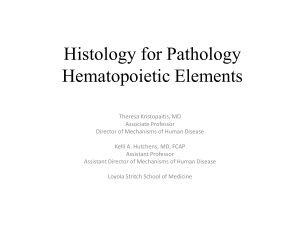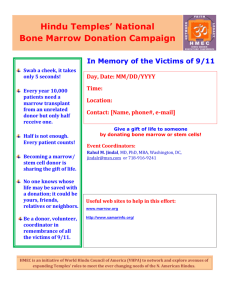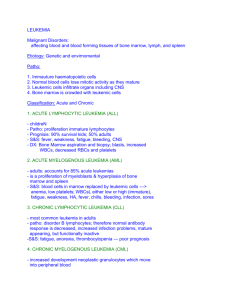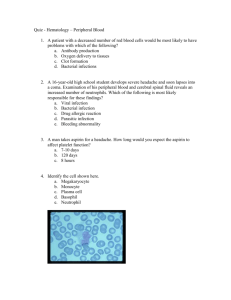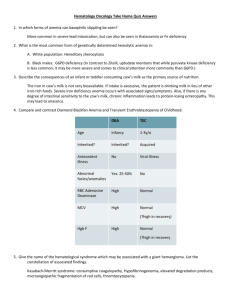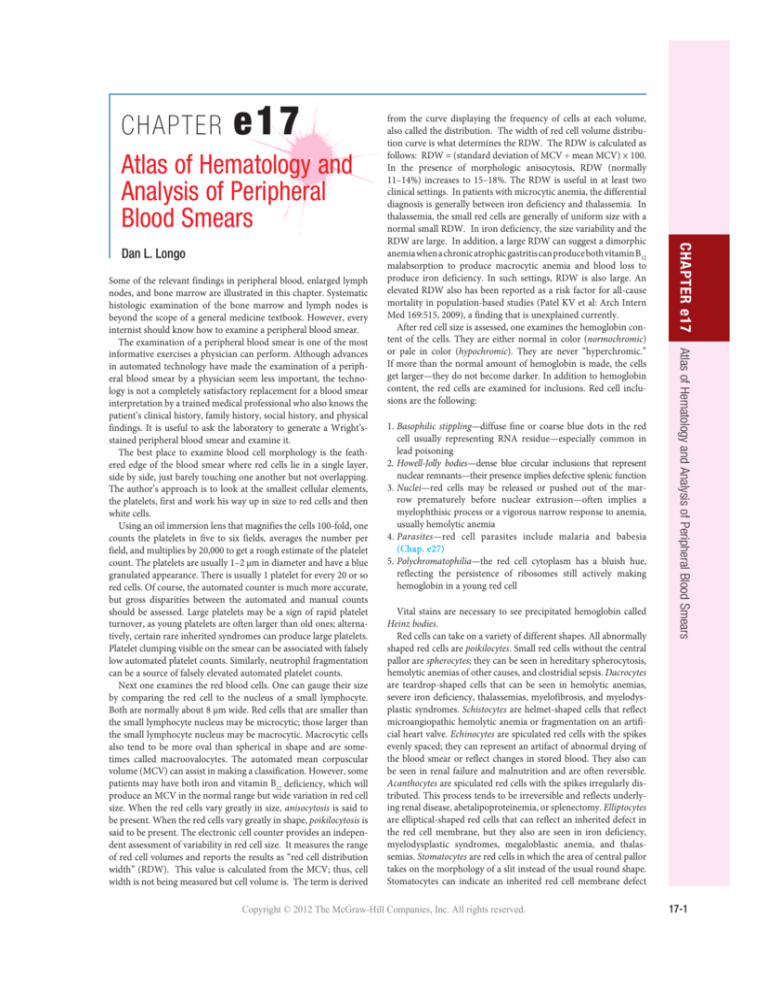
C H AP T E R e1 7
Atlas of Hematology and
Analysis of Peripheral
Blood Smears
Some of the relevant findings in peripheral blood, enlarged lymph
nodes, and bone marrow are illustrated in this chapter. Systematic
histologic examination of the bone marrow and lymph nodes is
beyond the scope of a general medicine textbook. However, every
internist should know how to examine a peripheral blood smear.
The examination of a peripheral blood smear is one of the most
informative exercises a physician can perform. Although advances
in automated technology have made the examination of a peripheral blood smear by a physician seem less important, the technology is not a completely satisfactory replacement for a blood smear
interpretation by a trained medical professional who also knows the
patient’s clinical history, family history, social history, and physical
findings. It is useful to ask the laboratory to generate a Wright’sstained peripheral blood smear and examine it.
The best place to examine blood cell morphology is the feathered edge of the blood smear where red cells lie in a single layer,
side by side, just barely touching one another but not overlapping.
The author’s approach is to look at the smallest cellular elements,
the platelets, first and work his way up in size to red cells and then
white cells.
Using an oil immersion lens that magnifies the cells 100-fold, one
counts the platelets in five to six fields, averages the number per
field, and multiplies by 20,000 to get a rough estimate of the platelet
count. The platelets are usually 1–2 μm in diameter and have a blue
granulated appearance. There is usually 1 platelet for every 20 or so
red cells. Of course, the automated counter is much more accurate,
but gross disparities between the automated and manual counts
should be assessed. Large platelets may be a sign of rapid platelet
turnover, as young platelets are often larger than old ones; alternatively, certain rare inherited syndromes can produce large platelets.
Platelet clumping visible on the smear can be associated with falsely
low automated platelet counts. Similarly, neutrophil fragmentation
can be a source of falsely elevated automated platelet counts.
Next one examines the red blood cells. One can gauge their size
by comparing the red cell to the nucleus of a small lymphocyte.
Both are normally about 8 μm wide. Red cells that are smaller than
the small lymphocyte nucleus may be microcytic; those larger than
the small lymphocyte nucleus may be macrocytic. Macrocytic cells
also tend to be more oval than spherical in shape and are sometimes called macroovalocytes. The automated mean corpuscular
volume (MCV) can assist in making a classification. However, some
patients may have both iron and vitamin B12 deficiency, which will
produce an MCV in the normal range but wide variation in red cell
size. When the red cells vary greatly in size, anisocytosis is said to
be present. When the red cells vary greatly in shape, poikilocytosis is
said to be present. The electronic cell counter provides an independent assessment of variability in red cell size. It measures the range
of red cell volumes and reports the results as “red cell distribution
width” (RDW). This value is calculated from the MCV; thus, cell
width is not being measured but cell volume is. The term is derived
1. Basophilic stippling—diffuse fine or coarse blue dots in the red
cell usually representing RNA residue—especially common in
lead poisoning
2. Howell-Jolly bodies—dense blue circular inclusions that represent
nuclear remnants—their presence implies defective splenic function
3. Nuclei—red cells may be released or pushed out of the marrow prematurely before nuclear extrusion—often implies a
myelophthisic process or a vigorous narrow response to anemia,
usually hemolytic anemia
4. Parasites—red cell parasites include malaria and babesia
(Chap. e27)
5. Polychromatophilia—the red cell cytoplasm has a bluish hue,
reflecting the persistence of ribosomes still actively making
hemoglobin in a young red cell
Vital stains are necessary to see precipitated hemoglobin called
Heinz bodies.
Red cells can take on a variety of different shapes. All abnormally
shaped red cells are poikilocytes. Small red cells without the central
pallor are spherocytes; they can be seen in hereditary spherocytosis,
hemolytic anemias of other causes, and clostridial sepsis. Dacrocytes
are teardrop-shaped cells that can be seen in hemolytic anemias,
severe iron deficiency, thalassemias, myelofibrosis, and myelodysplastic syndromes. Schistocytes are helmet-shaped cells that reflect
microangiopathic hemolytic anemia or fragmentation on an artificial heart valve. Echinocytes are spiculated red cells with the spikes
evenly spaced; they can represent an artifact of abnormal drying of
the blood smear or reflect changes in stored blood. They also can
be seen in renal failure and malnutrition and are often reversible.
Acanthocytes are spiculated red cells with the spikes irregularly distributed. This process tends to be irreversible and reflects underlying renal disease, abetalipoproteinemia, or splenectomy. Elliptocytes
are elliptical-shaped red cells that can reflect an inherited defect in
the red cell membrane, but they also are seen in iron deficiency,
myelodysplastic syndromes, megaloblastic anemia, and thalassemias. Stomatocytes are red cells in which the area of central pallor
takes on the morphology of a slit instead of the usual round shape.
Stomatocytes can indicate an inherited red cell membrane defect
Copyright © 2012 The McGraw-Hill Companies, Inc. All rights reserved.
CHAPTER e17 Atlas of Hematology and Analysis of Peripheral Blood Smears
Dan L. Longo
from the curve displaying the frequency of cells at each volume,
also called the distribution. The width of red cell volume distribution curve is what determines the RDW. The RDW is calculated as
follows: RDW = (standard deviation of MCV ÷ mean MCV) × 100.
In the presence of morphologic anisocytosis, RDW (normally
11–14%) increases to 15–18%. The RDW is useful in at least two
clinical settings. In patients with microcytic anemia, the differential
diagnosis is generally between iron deficiency and thalassemia. In
thalassemia, the small red cells are generally of uniform size with a
normal small RDW. In iron deficiency, the size variability and the
RDW are large. In addition, a large RDW can suggest a dimorphic
anemia when a chronic atrophic gastritis can produce both vitamin B12
malabsorption to produce macrocytic anemia and blood loss to
produce iron deficiency. In such settings, RDW is also large. An
elevated RDW also has been reported as a risk factor for all-cause
mortality in population-based studies (Patel KV et al: Arch Intern
Med 169:515, 2009), a finding that is unexplained currently.
After red cell size is assessed, one examines the hemoglobin content of the cells. They are either normal in color (normochromic)
or pale in color (hypochromic). They are never “hyperchromic.”
If more than the normal amount of hemoglobin is made, the cells
get larger—they do not become darker. In addition to hemoglobin
content, the red cells are examined for inclusions. Red cell inclusions are the following:
17-1
PART 2
Cardinal Manifestations and Presentation of Diseases
17-2
and also can be seen in alcoholism. Target cells have an area of
central pallor that contains a dense center, or bull’s-eye. These cells
are seen classically in thalassemia, but they are also present in iron
deficiency, cholestatic liver disease, and some hemoglobinopathies.
They also can be generated artifactually by improper slide making.
One last feature of the red cells to assess before moving to the
white blood cells is the distribution of the red cells on the smear.
In most individuals, the cells lie side by side in a single layer. Some
patients have red cell clumping (called agglutination) in which the
red cells pile upon one another; it is seen in certain paraproteinemias and autoimmune hemolytic anemias. Another abnormal
distribution involves red cells lying in single cell rows on top of one
another like stacks of coins. This is called rouleaux formation and
reflects abnormal serum protein levels.
Finally, one examines the white blood cells. Three types of
granulocytes are usually present: neutrophils, eosinophils, and
basophils, in decreasing frequency. Neutrophils are generally the
most abundant white cell. They are round, are 10–14 μm wide,
and contain a lobulated nucleus with two to five lobes connected
by a thin chromatin thread. Bands are immature neutrophils that
have not completed nuclear condensation and have a U-shaped
nucleus. Bands reflect a left shift in neutrophil maturation in an
effort to make more cells more rapidly. Neutrophils can provide
clues to a variety of conditions. Vacuolated neutrophils may be a
sign of bacterial sepsis. The presence of 1- to 2-μm blue cytoplasmic inclusions, called Döhle bodies, can reflect infections, burns,
or other inflammatory states. If the neutrophil granules are larger
than normal and stain a darker blue, “toxic granulations” are said
to be present, and they also suggest a systemic inflammation. The
presence of neutrophils with more than five nuclear lobes suggests
megaloblastic anemia. Large misshapen granules may reflect the
inherited Chédiak-Higashi syndrome.
Eosinophils are slightly larger than neutrophils, have bilobed
nuclei, and contain large red granules. Diseases of eosinophils are
associated with too many of them rather than any morphologic or
qualitative change. They normally total less than one-thirtieth the
number of neutrophils. Basophils are even more rare than eosinophils in the blood. They have large dark blue granules and may be
increased as part of chronic myeloid leukemia.
Lymphocytes can be present in several morphologic forms.
Most common in healthy individuals are small lymphocytes with
a small dark nucleus and scarce cytoplasm. In the presence of viral
infections, more of the lymphocytes are larger, about the size of
neutrophils, with abundant cytoplasm and a less condensed nuclear
chromatin. These cells are called reactive lymphocytes. About 1%
of lymphocytes are larger and contain blue granules in a light blue
cytoplasm; they are called large granular lymphocytes. In chronic
lymphoid leukemia, the small lymphocytes are increased in number, and many of them are ruptured in making the blood smear,
leaving a smudge of nuclear material without a surrounding cytoplasm or cell membrane; they are called smudge cells and are rare in
the absence of chronic lymphoid leukemia.
Monocytes are the largest white blood cells, ranging from 15 to
22 μm in diameter. The nucleus can take on a variety of shapes but
usually appears to be folded; the cytoplasm is gray.
Abnormal cells may appear in the blood. Most often the abnormal cells originate from neoplasms of bone marrow–derived cells,
including lymphoid cells, myeloid cells, and occasionally red cells.
More rarely, other types of tumors can get access to the bloodstream, and rare epithelial malignant cells may be identified. The
chances of seeing such abnormal cells is increased by examining
blood smears made from buffy coats, the layer of cells that is visible on top of sedimenting red cells when blood is left in the test
tube for an hour. Smears made from finger sticks may include rare
endothelial cells.
Figure e17-1 Normal peripheral blood smear. Small lymphocyte in
center of field. Note that the diameter of the red blood cell is similar to the
diameter of the small lymphocyte nucleus.
Figure e17-2 Reticulocyte count preparation. This new methylene
blue–stained blood smear shows large numbers of heavily stained reticulocytes (the cells containing the dark blue–staining RNA precipitates).
Figure e17-3 Hypochromic microcytic anemia of iron deficiency.
Small lymphocyte in field helps assess the red blood cell size.
Copyright © 2012 The McGraw-Hill Companies, Inc. All rights reserved.
Figure e17-7 Hypersegmented neutrophils. Hypersegmented neutrophils (multilobed polymorphonuclear leukocytes) are larger than normal
neutrophils with five or more segmented nuclear lobes. They are commonly
seen with folic acid or vitamin B12 deficiency.
Figure e17-5
coloring.
Polychromatophilia. Note large red cells with light purple
Figure e17-8 Spherocytosis. Note small hyperchromatic cells without
the usual clear area in the center.
Figure e17-6 Macrocytosis. These cells are both larger than normal
(mean corpuscular volume >100) and somewhat oval in shape. Some morphologists call these cells macroovalocytes.
Figure e17-9 Rouleaux formation. Small lymphocyte in center of field.
These red cells align themselves in stacks and are related to increased
serum protein levels.
Copyright © 2012 The McGraw-Hill Companies, Inc. All rights reserved.
CHAPTER e17 Atlas of Hematology and Analysis of Peripheral Blood Smears
Figure e17-4 Iron deficiency anemia next to normal red blood cells.
Microcytes (right panel ) are smaller than normal red blood cells (cell diameter <7 µm) and may or may not be poorly hemoglobinized (hypochromic).
17-3
PART 2
Cardinal Manifestations and Presentation of Diseases
Figure e17-10 Red cell agglutination. Small lymphocyte and segmented
neutrophil in upper left center. Note irregular collections of aggregated red
cells.
Figure e17-13 Target cells. Target cells are recognized by the bull’seye appearance of the cell. Small numbers of target cells are seen with
liver disease and thalassemia. Larger numbers are typical of hemoglobin C
disease.
Figure e17-11
Figure e17-14 Elliptocytosis. Small lymphocyte in center of field.
Elliptical shape of red cells related to weakened membrane structure, usually
due to mutations in spectrin.
Fragmented red cells. Heart valve hemolysis.
Figure e17-12 Sickle cells. Homozygous sickle cell disease. A nucleated
red cell and neutrophil are also in the field.
17-4
Figure e17-15 Stomatocytosis. Red cells characterized by a wide transverse slit or stoma. This often is seen as an artifact in a dehydrated blood
smear. These cells can be seen in hemolytic anemias and in conditions in
which the red cell is overhydrated or dehydrated.
Copyright © 2012 The McGraw-Hill Companies, Inc. All rights reserved.
Figure e17-19 Myelofibrosis of the bone marrow. Total replacement
of marrow precursors and fat cells by a dense infiltrate of reticulin fibers and
collagen (H&E stain).
Figure e17-17 Howell-Jolly bodies. Howell-Jolly bodies are tiny nuclear
remnants that normally are removed by the spleen. They appear in the blood
after splenectomy (defect in removal) and with maturation/dysplastic disorders (excess production).
Figure e17-20 Reticulin stain of marrow myelofibrosis. Silver stain of
a myelofibrotic marrow showing an increase in reticulin fibers (black-staining
threads).
Figure e17-18 Teardrop cells and nucleated red blood cells characteristic of myelofibrosis. A teardrop-shaped red blood cell (left panel ) and
a nucleated red blood cell (right panel ) as typically seen with myelofibrosis
and extramedullary hematopoiesis.
CHAPTER e17 Atlas of Hematology and Analysis of Peripheral Blood Smears
Figure e17-16 Acanthocytosis. Spiculated red cells are of two types:
acanthocytes are contracted dense cells with irregular membrane projections
that vary in length and width; echinocytes have small, uniform, and evenly
spaced membrane projections. Acanthocytes are present in severe liver disease, in patients with abetalipoproteinemia, and in rare patients with McLeod
blood group. Echinocytes are found in patients with severe uremia, in glycolytic red cell enzyme defects, and in microangiopathic hemolytic anemia.
Figure e17-21 Stippled red cell in lead poisoning. Mild hypochromia.
Coarsely stippled red cell.
Copyright © 2012 The McGraw-Hill Companies, Inc. All rights reserved.
17-5
PART 2
Figure e17-22 Heinz bodies. Blood mixed with hypotonic solution of
crystal violet. The stained material is precipitates of denatured hemoglobin
within cells.
Cardinal Manifestations and Presentation of Diseases
Figure e17-23 Giant platelets. Giant platelets, together with a marked
increase in the platelet count, are seen in myeloproliferative disorders, especially primary thrombocythemia.
Figure e17-26 Normal eosinophils. The film was prepared from the
buffy coat of the blood from a normal donor. N, neutrophil; E, eosinophil;
L, lymphocyte.
Figure e17-24 Normal granulocytes. The normal granulocyte has a segmented nucleus with heavy, clumped chromatin; fine neutrophilic granules
are dispersed throughout the cytoplasm.
17-6
Figure e17-25 Normal monocytes. The film was prepared from the
buffy coat of the blood from a normal donor. L, lymphocyte; M monocyte;
N, neutrophil.
Figure e17-27 Normal basophil. The film was prepared from the buffy
coat of the blood from a normal donor. L, lymphocyte; B, basophil.
Copyright © 2012 The McGraw-Hill Companies, Inc. All rights reserved.
Figure e17-29 Döhle body. Neutrophil band with Döhle body. The neutrophil with a sausage-shaped nucleus in the center of the field is a band
form. Döhle bodies are discrete, blue-staining nongranular areas found in
the periphery of the cytoplasm of the neutrophil in infections and other toxic
states. They represent aggregates of rough endoplasmic reticulum.
Figure e17-30
neutrophil.
Chédiak-Higashi disease. Note giant granules in
Figure e17-31 Normal bone marrow. Low-power view of normal adult
marrow (H&E stain), showing a mix of fat cells (clear areas) and hematopoietic cells. The percentage of the space that consists of hematopoietic cells
is referred to as marrow cellularity. In adults, normal marrow cellularity is
35–40%. If demands for increased marrow production occur, cellularity
may increase to meet the demand. As people age, the marrow cellularity
decreases and the marrow fat increases. Patients >70 years old may have
a 20–30% marrow cellularity.
Figure e17-32 Aplastic anemia bone marrow. Normal hematopoietic
precursor cells are virtually absent, leaving behind fat cells, reticuloendothelial cells, and the underlying sinusoidal structure.
CHAPTER e17 Atlas of Hematology and Analysis of Peripheral Blood Smears
Figure e17-28 Pelger-Hüet anomaly. In this benign disorder, the majority
of granulocytes are bilobed. The nucleus frequently has a spectacle-like, or
“pince-nez,” configuration.
Figure e17-33 Metastatic cancer in the bone marrow. Marrow biopsy
specimen infiltrated with metastatic breast cancer and reactive fibrosis (H&E
stain).
Copyright © 2012 The McGraw-Hill Companies, Inc. All rights reserved.
17-7
PART 2
Cardinal Manifestations and Presentation of Diseases
17-8
Figure e17-34 Lymphoma in the bone marrow. Nodular (follicular)
lymphoma infiltrate in a marrow biopsy specimen. Note the characteristic
paratrabecular location of the lymphoma cells.
Figure e17-37 Megaloblastic erythropoiesis. High-power view of
megaloblastic red blood cell precursors from a patient with a macrocytic
anemia. Maturation is delayed, with late normoblasts showing a more
immature-appearing nucleus with a lattice-like pattern with normal cytoplasmic maturation.
A
B
C
D
Figure e17-35 Erythroid hyperplasia of the marrow. Marrow aspirate
specimen with a myeloid/erythroid ratio (M/E ratio) of 1:1–2, typical for a
patient with a hemolytic anemia or one recovering from blood loss.
Figure e17-38 Prussian blue staining of marrow iron stores. Iron
stores can be graded on a scale of 0 to 4+. A: a marrow with excess
iron stores (>4+); B: normal stores (2–3+); C: minimal stores (1+); and
D: absent iron stores (0).
Figure e17-36 Myeloid hyperplasia of the marrow. Marrow aspirate
specimen showing a myeloid/erythroid ratio of ≥3:1, suggesting either a loss
of red blood cell precursors or an expansion of myeloid elements.
Figure e17-39 Ringed sideroblast. An orthochromatic normoblast with
a collar of blue granules (mitochondria encrusted with iron) surrounding the
nucleus.
Copyright © 2012 The McGraw-Hill Companies, Inc. All rights reserved.
Acute lymphoblastic leukemia.
Figure e17-44
Burkitt’s leukemia, acute lymphoblastic leukemia.
Figure e17-45
Chronic myeloid leukemia in the peripheral blood.
Figure e17-40 Acute myeloid leukemia. Leukemic myeloblast with an
Auer rod. Note two to four large, prominent nucleoli in each cell.
CHAPTER e17 Atlas of Hematology and Analysis of Peripheral Blood Smears
Figure e17-43
Figure e17-41 Acute promyelocytic leukemia. Note prominent cytoplasmic granules in the leukemia cells.
Figure e17-42 Acute erythroleukemia. Note giant dysmorphic erythroblasts; two are binucleate, and one is multinucleate.
Copyright © 2012 The McGraw-Hill Companies, Inc. All rights reserved.
17-9
PART 2
Cardinal Manifestations and Presentation of Diseases
17-10
Figure e17-46
Chronic lymphoid leukemia in the peripheral blood.
Figure e17-49 Follicular lymphoma in a lymph node. The normal nodal
architecture is effaced by nodular expansions of tumor cells. Nodules vary in
size and contain predominantly small lymphocytes with cleaved nuclei along
with variable numbers of larger cells with vesicular chromatin and prominent
nucleoli.
Figure e17-47 Sézary’s syndrome. Lymphocytes with frequently convoluted nuclei (Sézary cells) in a patient with advanced mycosis fungoides.
Figure e17-50 Diffuse large B cell lymphoma in a lymph node. The
neoplastic cells are heterogeneous but predominantly large cells with vesicular chromatin and prominent nucleoli.
Figure e17-48 Adult T cell leukemia. Peripheral blood smear showing
leukemia cells with typical “flower-shaped” nucleus.
Figure e17-51 Burkitt’s lymphoma in a lymph node. Burkitt’s lymphoma with starry-sky appearance. The lighter areas are macrophages
attempting to clear dead cells.
Copyright © 2012 The McGraw-Hill Companies, Inc. All rights reserved.
Figure e17-53 Hodgkin’s disease. A Reed-Sternberg cell is present near
the center of the field; a large cell with a bilobed nucleus and prominent
nucleoli giving an “owl’s eyes” appearance. The majority of the cells are
normal lymphocytes, neutrophils, and eosinophils that form a pleiomorphic
cellular infiltrate.
Figure e17-55
Normal plasma cell.
Figure e17-56
Multiple myeloma.
Figure e17-54 Lacunar cell; Reed-Sternberg cell variant in nodular
sclerosing Hodgkin’s disease. High-power view of single mononuclear
Figure e17-57 Color serum in hemoglobinemia. The distinctive red
lacunar cell with retracted cytoplasm in a patient with nodular sclerosing
coloration of plasma (hemoglobinemia) in a spun blood sample in a patient
Hodgkin’s disease.
with intravascular hemolysis.
Copyright © 2012 The McGraw-Hill Companies, Inc. All rights reserved.
CHAPTER e17 Atlas of Hematology and Analysis of Peripheral Blood Smears
Figure e17-52 Erythrophagocytosis accompanying aggressive lymphoma. The central macrophage is ingesting red cells, neutrophils, and
platelets. (Courtesy of Dr. Kiyomi Tsukimori, Kyushu University, Fukuoka,
Japan.)
17-11
ACKNOWLEDGMENT
Figures in this e-chapter were borrowed from Williams Hematology,
7th edition, M Lichtman et al (eds). New York, McGraw-Hill, 2005;
Hematology in General Practice, 4th edition, RS Hillman, KA Ault,
New York, McGraw-Hill, 2005.
PART 2
Cardinal Manifestations and Presentation of Diseases
17-12
Copyright © 2012 The McGraw-Hill Companies, Inc. All rights reserved.

